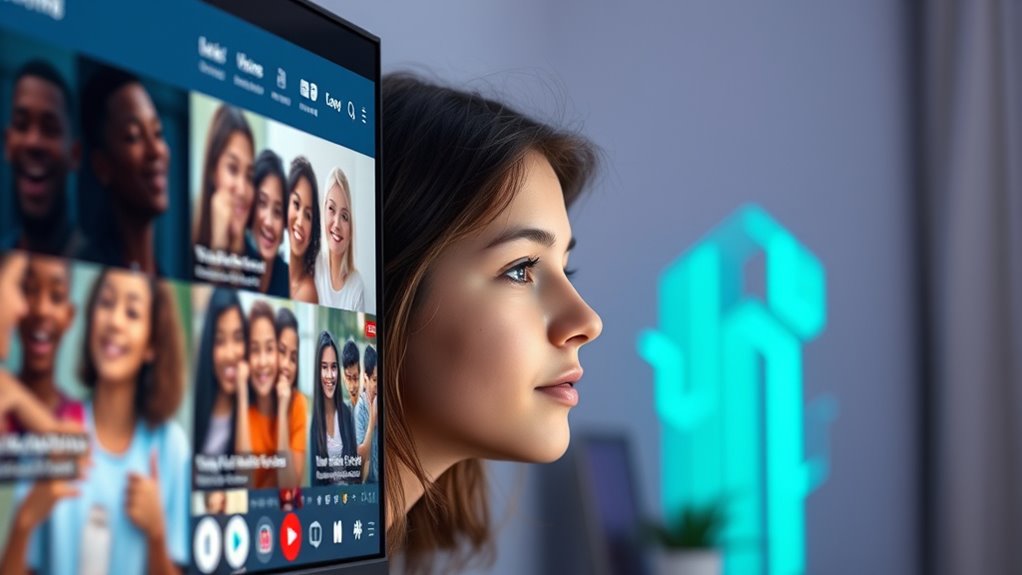YouTube uses artificial intelligence to better protect teens from harmful content by improving moderation and increasing transparency in its algorithms. The platform employs AI tools to detect issues like cyberbullying, hate speech, and violence in real time while also explaining how videos are recommended. Although AI isn’t perfect, YouTube continually updates its systems to make certain a safer environment. If you want to see how these safety measures work, there’s more to learn below.
Key Takeaways
- YouTube uses AI-powered algorithms to detect and filter harmful content before it reaches teenage users.
- The platform enhances transparency by explaining how its recommendation system operates.
- AI tools automatically flag videos with cyberbullying, hate speech, or violence for review.
- Human moderators review flagged content to ensure accurate enforcement and context understanding.
- Continuous AI improvements help adapt to new harmful content, strengthening safety measures for teens.

Have you ever wondered how platforms like YouTube are working to keep teens safe online? It’s a pressing question, especially as more young people spend hours scrolling through videos each day. YouTube has stepped up its game by leveraging artificial intelligence to enhance safety measures, focusing on algorithm transparency and content moderation. These efforts aim to reduce exposure to harmful content without sacrificing the personalized experience users expect.
YouTube uses AI to protect teens online through transparency and content moderation efforts.
When it comes to algorithm transparency, YouTube is making strides to clarify how its recommendation system works. You might notice that the platform is trying to be more open about how videos are suggested and prioritized. This isn’t just about showing you popular content; it’s about ensuring that the algorithms don’t inadvertently promote harmful or misleading videos. By providing more insight into its recommendation processes, YouTube helps users understand why certain videos appear on their feed, giving teens and their guardians a clearer picture of how content is curated. Additionally, ongoing security assessments help improve the overall safety infrastructure of the platform.
Content moderation is another critical piece of the puzzle. YouTube employs advanced AI tools to scan videos for violations of community guidelines, flagging potentially harmful material before it reaches a wide audience. These AI systems analyze video content, comments, and metadata in real time, enabling faster and more accurate detection of issues like cyberbullying, hate speech, or graphic violence. This proactive approach helps prevent teens from encountering damaging content, while human moderators review flagged videos to ensure fair judgment and context consideration.
YouTube’s AI-driven content moderation isn’t perfect, but it’s a significant step toward creating a safer online environment. The platform continually trains its algorithms to better recognize harmful patterns and adapt to new forms of inappropriate content. This ongoing refinement, combined with increased transparency about how decisions are made, encourages trust among users and their families. It also empowers teens to make smarter choices about what they watch, knowing that the platform is actively working to filter out dangerous material.
Ultimately, YouTube’s focus on algorithm transparency and content moderation reflects a broader commitment to protecting its youngest viewers. By harnessing AI intelligently, the platform aims to strike a balance between maintaining freedom of expression and ensuring safety. As a user, you can feel more confident that your online experience is being carefully monitored and improved, giving you peace of mind while you explore, learn, and create on the platform.
Frequently Asked Questions
How Effective Are Youtube’s AI Filters in Preventing Harmful Content?
You’ll find that YouTube’s AI filters are fairly effective, but their algorithm accuracy isn’t perfect. They catch most harmful content early, helping protect teens, yet some slip through. You might also notice that moderation transparency varies, making it hard to see exactly how decisions are made. Overall, these filters improve safety, but you should still stay vigilant, as no system can catch everything 100% of the time.
Will AI Censorship Impact Creators’ Freedom of Expression?
AI censorship may influence your freedom of expression by limiting what you can share, but increased algorithm transparency helps you understand these restrictions better. You might feel constrained, yet these measures aim to protect viewers, especially teens. Balancing creator autonomy with safety is essential; as AI evolves, staying informed and advocating for clearer guidelines ensures your voice remains authentic without crossing harmful boundaries.
How Does Youtube Balance Safety With User Privacy Concerns?
Imagine a creator worried about privacy when YouTube’s algorithm suggests content. YouTube balances safety with user privacy by prioritizing transparency about how algorithms work and seeking user consent before collecting data. They implement clear policies and give users control over their privacy settings. This way, you’re protected from harmful content while your personal information remains secure, fostering trust and allowing you to enjoy the platform safely.
Are There Any False Positives in AI Content Moderation?
Yes, there are false positives in AI content moderation. You might find that the algorithm accuracy isn’t perfect, leading to innocent content being flagged or removed. This happens because moderation biases can influence the system, causing it to misinterpret context or nuance. While AI aims to protect users, it’s not flawless, so some false positives occur, and ongoing adjustments are necessary to improve moderation precision and fairness.
What Future AI Developments Are Planned for Content Safety?
You can anticipate future AI developments to focus on increasing transparency and reducing algorithm bias, making content moderation fairer and more accurate. Developers aim to create systems that explain their decisions clearly, so you understand why content is flagged or allowed. These improvements will ensure safer online environments, with AI becoming better at identifying harmful content without unjustly censoring legitimate material, ultimately protecting users while respecting free expression.
Conclusion
As you scroll through YouTube, imagine a guardian quietly watching over your screen, filtering out the shadows of harmful content. With AI at the helm, the platform becomes a safe harbor amid stormy seas, guiding teens away from dangerous waves. You can feel the reassurance as the digital landscape transforms into a brighter, more secure space—where curiosity is nurtured, and worries fade into the background, allowing you to explore with confidence and peace of mind.











